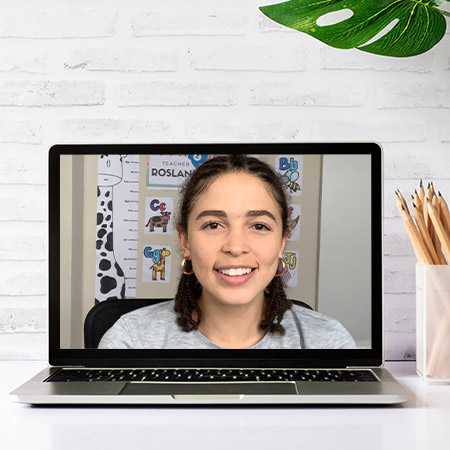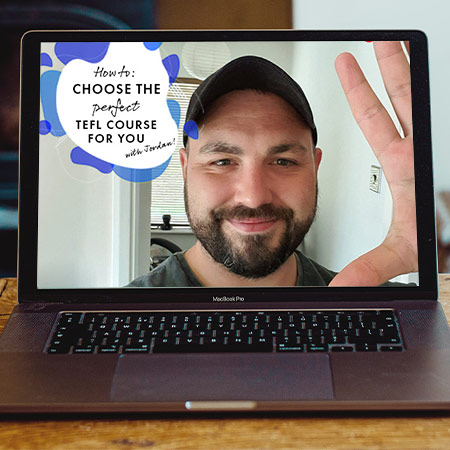You’ve landed your first TEFL job – fantastic! Now, you need to get ready for your very first TEFL class. To give your preparations a boost, TEFL teacher Shelby hosted a live webinar all about what to expect from your first TEFL class, whether it’s online or in person. Watch the full webinar or read on for edited extracts.
PREPARING FOR YOUR FIRST TEFL LESSON
Preparing your online TEFL workspace
What your online TEFL workspace looks like depends on the company you’re teaching for. For example, I teach for an online company that requires a backdrop with their logo on it. To prepare for my first lesson, I had to print the logo, make sure it would stay on the wall and check that my camera was set up so students could see both my face and the logo. For another company, I needed a green screen behind me, so I had to order that online before I started teaching.
As well as the backdrop, you need good lighting and a good computer or laptop that will run the system your company uses. You also need a camera so the student can see how to pronounce words, as the way your lips and mouth move changes the pronunciation. I also use software called ManyCam as I like to do different things with my camera to make my lessons special. For some companies you might need a headset and, if you use an iPad, you might need an Apple pin to write smoothly.
I also always have water in a small glass, my phone near me (so I can easily see the time) and my iPad next to me, so I have my notes and know what is coming up. In my kitchen, I have crackers, fruit and coffee so I can get food easily – but I highly recommend you don’t eat during your class.
If you’re not sure what to wear, ask the company that you’re working for. I work for one company where I have to wear a blue shirt and for another company where I have to wear a collared shirt. I don’t wear business clothes because I’m an English teacher and they should be able to connect with me as a person. They should not feel intimidated by me.
I encourage you to test your equipment in the same environment as you’ll be using for teaching – make sure the lighting and the sound is the same. I tested my green screen at night and it looked great. The next day, when the sun was up, there were different shadows, so I had to change the way it was set up five minutes before the class started.
Planning online TEFL lessons & materials
To prepare for your online TEFL lessons, you need to plan the curriculum and know what goals you need to hit. You don’t need to write every lesson plan until the end of the course but you do need to know where you’re going so you can scaffold with your students – you don’t want to teach present continuous if you’ve not taught present, for example.
Review your lesson in advance, so you can find any props or print any pictures that you need. I sometimes buy props like finger puppets from a cheap store and I look up images on Google – if they’re free to use, you can add them to your webcam. You can also find a lot of props in your house, such as a lamp or a phone. Make sure you have all your props ready and within reach before your class. You don’t want to say, ‘Let’s learn “spoon”’ and then have to leave the camera to get your spoon.
When you’re planning individual lessons, think about the timing. For example, if your student isn’t a big talker, you’re not going to spend five minutes saying, ‘Hello.’ I have a lot of extra activities related to a lesson so, if a student is ahead of their schedule, I’m able to add games, activities, stories – ways for them to get the full time they’ve paid for. I encourage you to find resources and bookmark them on your computer, so you can easily pull up something if you need extra activities.
Preparing for your first day in a school
When you’re teaching in person, typically you have to go somewhere, so plan and test your route. Go to your school before your first class and see how long it takes you to get there –you don’t want to be late. I make sure I pack my backpack the night before. That has my laptop, my iPad, my water and any special props that are not at my school. If you need snacks, check if there’s a snack bar or vending machine in your school or buy your own and bring what you need for that day.
Before you start teaching at your school, make sure you have a conversation with the School Director. You need to know what type of course you’re teaching and what level the students are, so you can prepare your lessons. Another important question to ask if whether the school will give you the curriculum. Normally, a school or a language centre has a curriculum and then you make your lesson plans within that curriculum but you might encounter a school that wants you to make your own curriculum.
Another thing to check is if there’s a dress code. Some schools have uniforms or require you to wear a suit and tie. I wear business casual which, for me, is jeans and a shirt that has a collar of some form. I look relaxed and approachable but professional.
I went to my school to meet the Director before I started teaching. It allowed me to see the school and the classroom and to check what resources they had, so I could plan my courses. It really helped me.
Find out about students and resources
When you go to a school for the first time, people will offer a lot of help. Take advantage of that, go out to eat with your co-workers, hear how their experience has been. They might have taught your course or students and give you a lot of useful tips and tricks. That happened to me – because I interacted with the staff before my first day of actual teaching, I was prepared for situations such as which students were not active in class and which students didn’t ever do their homework.
You typically don’t need to buy a lot of equipment to teach in a school as they have most of it already. If they don’t have particular colours of paper or specific books, the school might buy it for you or you can try to make another version. I’m very fortunate that my school has advanced technology. My classrooms have whiteboards, monitors, computers, screens and pins for the students to write on the board digitally. I can print at my school and we have a large resource room. I highly encourage you not to buy too much for an in-person course. You don’t want the majority of your money to go towards props.
YOUR FIRST TEFL LESSON
How to start your first lesson
When you’re meeting new students, remember they’re nervous of you as well. You’re the fluent English speaker, you’re the one with the authority. Be charming and create a positive vibe in the classroom. I think it’s important to be very professional, even if you’re teaching little kids. That doesn’t mean you can’t be fun and engaging but their parents are paying for these classes. They want a good teacher that the students can respect and learn from.
Always understand your audience. If you’re introducing yourself to a class of kids who don’t speak English, keep your introduction very simple. If you’re talking to adults or younger students who have a good base of English, you can use full sentences and say who you are, what you do, where you come from, what your hobbies are.
Ease your students’ nerves by bouncing around, so you don’t call on a student more than once and interact with them, add videos into your courses, add projects – working in groups helps them to be less nervous than if they’re waiting for a teacher to ask them to say a grammatically correct sentence.
How to manage a TEFL lesson
It’s important to introduce your lesson to your class or else your students will be anxious that they don’t know what you’re talking about. I write everything I’ll be teaching on a whiteboard at the start of the lesson. For example, it will say, ‘September 3rd. Food vocabulary. Present continuous. Animals,’ so they know exactly what I’ll be teaching that day. They are ready. They can flip in their notes or book and see what I’m talking about.
In your TEFL course you’ll also learn how to work with presentation of vocabulary and presentation of grammar. A lot of teachers will say, ‘Today we will learn this. What is it?’ and everyone is silent. Instead, you should present: ‘This is a cup. We drink from a cup. Jim, what is it?’ ‘It’s a cup.’ ‘Yes, very good.’
Take the time to get to know your students and make them feel special. Talk to different students and bounce around. Students can be very easily distracted, especially when you teach online, so you need ways to keep them engaged. I use in-person props and pictures on the screen, which allows the lessons to be versatile. Changing things in your lesson to keep them engaged and using new words is incredibly important.
Students also really thrive when they’re learning through project-based learning. For example, when I was teaching vocabulary related to sustainability, my students had to make a poster board about sustainability and present it to the class. They were using the words while talking to the students in their groups, they were writing them on the poster board and then they were presenting them.
It’s also important to stay on track with your schedule. If you know you’re presenting grammar for five minutes, present your grammar for five minutes and move on. If you present grammar for 45 minutes in an hour class, the students will be bored and you’ll not have enough time for production, games and activities. You need to manage your class or the students will never achieve their goals.
How to end a TEFL lesson
I always end my TEFL lesson by asking, ‘What is a new word you’ve learnt today? Can you use your word in a sentence?’ I want the last thing that they remember is saying something new. They’re normally paying a lot of money for these English classes. They need to be taking something home with them.
I also write their homework on the board and have them write it in their books. I don’t like excuses of, ‘I forgot what page it was.’ I leave those last two things in their heads so we’re prepared for their next class. I also will often tell them what we’ll learn in the next class – some students practise beforehand, which is always okay with me.
TEFL PRACTICALITIES
Tools for Planning & Delivering Lessons
I plan my lessons in Google Sheets (which is like Excel). I make tasks for each course, have columns for different students and track what I taught that student in the class. I can keep up with what tenses we’re learning, what practices we’re doing and if we’ve read books, so we don’t read them again. I also can easily search the history of what I did with a student.
I use Google Docs for my teaching files. It’s full of books, images and resources. When I see something that I like, I save it, which allows me to have so many resources that I can use on demand. I also use resources and lesson plans from i-to-i’s resource packs and find short videos on YouTube to explain things.
For online teaching, I highly recommend Zoom. I’ve used other platforms but I find they’re more restricted. My camera is ManyCam so I can interact with other features and can have my students drawing. You just need to turn on those settings.
I like to have everything digital but lots of people write out their lesson plans. I keep my iPad on my desk in class, so I can see my lesson plan. It’s very easy for me to access my Google Sheets or find an extra resource.
TEFL Pay & Bookings
If you work for a school, your school handles the bookings and fees. I normally have an average of 10 students for an in-person class with my school but I’ve had some larger classes and a class with only two students.
If you teach for an online company, they’ll tell you their pay and how their booking system works. For example, I teach with PalFish and parents can choose to have a class with any teacher. If I open a spot on PalFish, it books immediately because the parents enjoyed the classes and they told their friends and then their friends told their friends. I also teach on Magic Ears where every student gets a random teacher. You could be the best teacher for Magic Ears and the student never gets to see you again because they don’t get to choose the teacher.
If you’re teaching privately, you set your own price. You know how much you’re worth and you know how much you need to survive and save. You might live in a country where you can charge students $5 or you might need $15 or $20. In Italy, I would say an English teacher would charge a minimum of 15 Euros and a maximum of 35 Euros – but that’s really pushing it. You need to find the middle ground and what is going to get you students. My schedule is fully booked so, hypothetically, I could probably charge more but I’m satisfied with where I am right now and I enjoy my students.
IN SUMMARY…
If you’ve not started your TEFL course yet, I recommend the i-to-i Advanced TEFL Diploma. A shorter course might get you a job but I did that and am now backtracking and doing my Diploma because I want those skills and to be even more competitive. In retrospect, I wish I’d done the Diploma in the beginning.
When you start teaching, there’s no such thing as over-preparing. Think about everything. What do you need that you don’t have and how will you get it? How early do you need to order it before it shows up? If you’re teaching at an in-person school, when will they give you the books you need to prepare your lesson? Will they give you a curriculum? How do you submit a request for the school to buy resources for you?
Think also about how you’re going to get to your school – both within the city but also how you’ll get to that city. Are there relocation expenses provided? Will the school pay for your apartment? Will you have WiFi if you’re teaching online the next day?
If you want to find out more, I’ve written a blog with my top tips for teaching English in Italy which is also relevant to moving to other foreign countries. Good luck with your TEFL course and the TEFL classes you teach!
FIND OUT MORE
Listen to the full webinar
Book your TEFL course today
Find Shelby on Instagram and Facebook: @shelbyelkins



